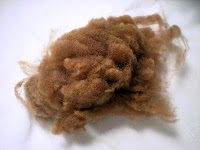Watered the garden that morning and went inside to start the laundry, only to have black water pour into the washer! I called my well guys and their first reaction, based on 60+ years experience, was that the bottom of the well had collapsed onto the submersible pump. When they arrived 4 hours later we started draining the tank and held a consultation. Meanwhile, the fellow dumping the drained water was rinsing out the bucket and noticed that the water was now running almost clear. A collapsed well does NOT suddenly run clear! So there is now a filter installed between the tank and the house water lines—we think that watering the garden caused the water table to drop and allowed particulates (a LOT of them) to enter the system. All is good now, but what a set of experiences and a lot of stress. I was exhausted and slept like a log on Friday night.
On a positive note, the blueberries and black raspberries are ripening at an alarming rate. It took me 90 minutes to pick them today!

Getting back to the CVM/Romeldale fleece, it has not been my best experience with a fleece. While teasing the locks I discovered a lot of second cuts, some of them ½” long, which means that the shearer was at fault here. In an already fine wool, second cuts make processing all that much more difficult. I picked out all that I could find but they still caused trouble in the carding. I didn’t dare put this through my drum carder so had to use hand cards.
 |
| This is the carded fleece without picking out second cuts |
 |
| This is the carded fleece after picking. Laborious picking. |
 |
| Rolags ready to go |
I spun the rolags on my Pipy wheel but wasn’t enjoying the experience due to the lumpiness. I know this yarn will not wear well; it will pill wildly. To compare I’ve included pix of a white CVM/Romeldale from Little Barn Farm which was processed by them and spun on my spindle. Yeah, I know the plying isn’t the best.
Even after washing the lumps are evident.

I will be going through this fleece very closely and trying to salvage what I can. I doubt there will be more than enough for a hat, a very lumpy hat. But that’s the risk we take when we buy a festival fleece. This particular fleece was rolled with the cut side out as required, but the second cuts weren’t evident when it was rolled. I purchased the front half of the fleece once it was unrolled and knew there were second cuts, but I didn’t inspect it closely enough to realize how much of the fleece staple had been chopped up. Live and Learn!















